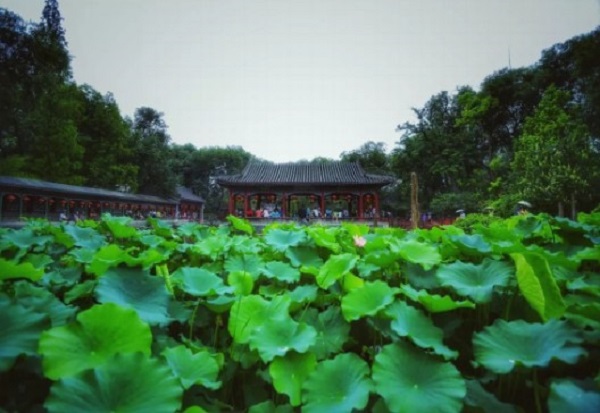
Pavilions are a special architectural form with Chinese characteristics. Traditional Chinese pavilions can be classified into many categories in terms of functions, building materials, and structures.

A traditional Chinese pavilion
In Chinese culture, the pragmatic functions of pavilions were to supervise the military deployment of enemies, demarcate administrative boundaries and create a place for people to rest. These pavilions were generally built along roads and usually very small and simple. Meanwhile, there are also many splendid pavilions built in gardens to enhance their aesthetic taste and allow people to take a sightseeing tour and get together with their friends.
The building materials of pavilions in China primarily include wood, stone, brick, grass, bamboo, and copper, which generally exercise an impact upon structural styles. Therefore, the utilization of different materials often presents us with varying visual effects. The majority of ancient Chinese buildings were made of wood.
Pavilions are generally built in the shape of triangles, rectangles, pentagons, hexagons, and octagons. There are single-eave and double-eave pavilions. Some of them are built with one set of pillars, while others are installed with two sets of pillars. The domes of the pavilions are usually round, rectangle, or triangle-shaped.

A sketch of different Chinese pavilions
All pavilions have their own stories and history. As a classical representative of traditional architecture during the Qing Dynasty (1644-1911), Prince Kung's Palace boasts a large number of pavilions, behind which there are lots of stories.
1. Miaoxiang Pavilion

Miaoxiang Pavilion in Prince Kung's Palace Museum
Miaoxiang Pavilion is a two-story square wooden structure with a flat roof. Its round roof and square platform embody the ancient Chinese belief of an orbicular sky and rectangular earth in the language of architecture. It was built in the shape of a begonia flower and decorated with exquisite patterns.
The first floor of the pavilion was referred to as Panna Hall and served as a worship area when Prince Kung lived. Meanwhile, the second floor was a place where Prince Kung and his family members drank tea and enjoyed beautiful scenes. The whole pavilion was known as the Miaoxiang Pavilion when Prince Kung's Palace was opened to the public in the 1980s. It has now become an ideal place for people to enjoy their tea in summer.
The Miaoxiang Pavilion was a popular destination for many domestic filmmakers in the past to shoot their movies. For instance, Jiang Wen, a veteran Chinese film director, selected it as one of the filming locations for his maiden work In the Heart of the Sun. In the film, several people sat on Yuguan Pass, on the left side of which is the Miaoxiang Pavilion.
2. Qinqiu Pavilion

Qinqiu Pavilion in Prince Kung's Palace Museum
Qinqiu Pavilion is another traditional building in Prince Kung's Palace. It was built with one set of pillars and has a round roof, and an eave with eight ridges.
There is a mini canal engraved on the ground of Qinqiu Pavilion. It looks like the Chinese characters of "water" and "longevity" from two different directions. Therefore, the special design of the pavilion has earned it the nickname "Shuishou" in Chinese.

Qinqiu Pavilion in Prince Kung's Palace Museum
Pavilion of Deep Autumns are recreational buildings with a long history in the art of traditional Chinese gardens. It is said that the special architecture derives from a folk gathering held annually by people in ancient times on the third day of the third month in the Chinese lunar calendar to take baths, call the spirit of a patient in critical condition or their ancestors, fend off disasters and aspire for happiness in accordance with superstitious beliefs. Later, the activity became integrated with a sightseeing tour in spring. People were expected to take a wine cup driven by flowing water, enjoy beautiful scenes and unite with their friends.
There are four such Pavilion of Deep Autumns in Beijing. The other three are located in Zhongnanhai, the Palace Museum and Tanzhe Temple, respectively.
3. Mid-lake Pavilion

Mid-lake Pavilion in Prince Kung's Palace Museum
The Mid-lake Pavilion is situated in the west of Prince Kung's Palace and is a major scenic site on the west road of the museum's garden. It was built with a set of wooden pillars and one round-ridge roof. The water in the pond is from Yuquan Lake and never flows to the outside world. According to fengshui, water symbolizes wealth. Therefore, the one-way flow of water reveals the hidden intention of its owner to become rich. It is believed that Prince Kung's Palace is located on one of two major prosperous and thriving axes in Beijing.

Mid-lake Pavilion in Prince Kung's Palace
The pond in front of the Mid-lake Pavilion has made it an ideal place for people to find a retreat in summer.
4. Chinese garden in Lazienki Palace Museum

Chinese garden in Royal Lazienki Museum
A Chinese garden can be found in the Royal Lazienki Museum of Poland. It is a group of classical Chinese buildings, which include waterfront pavilions, stone bridges, royal lamps, a footpath made of Chinese-style bricks, and lion statues, representing the friendship between the people of both countries.
The garden was designed and built by craftsmen from Prince Kung's Palace. These buildings have been integrated with the art of traditional Chinese architecture, literature, painting and sculpture, fully conveying the features of traditional Chinese culture.